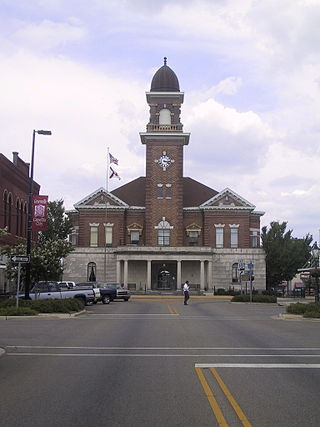
Butler County is a county located in the south central portion of the U.S. state of Alabama. As of the 2020 census, the population was 19,051. Its county seat is Greenville. Its name is in honor of Captain William Butler, who was born in Virginia and fought in the Creek War, and who was killed in May 1818.

Conecuh County is a county located in the south central portion of the U.S. state of Alabama. As of the 2020 census the population was 11,597. Its county seat is Evergreen. Its name is believed to be derived from a Creek Indian term meaning "land of cane."
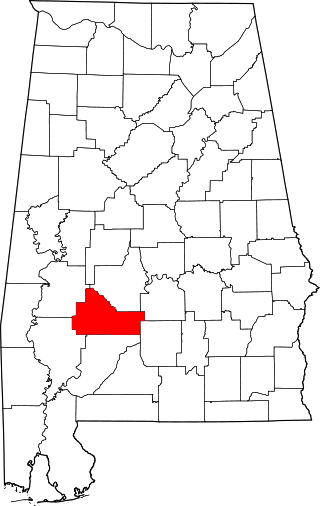
This is a list of the National Register of Historic Places listings in Wilcox County, Alabama.

Bride's Hill, known also as Sunnybrook, is a historic plantation house near Wheeler, Alabama. It is significant as an example of a Tidewater-type cottage. It was added to the Alabama Register of Landmarks and Heritage on April 16, 1985, and to the National Register of Historic Places on July 9, 1986.

Barton Hall, also known as the Cunningham Plantation, is an antebellum plantation house near present-day Cherokee, Alabama. Built in 1840, it is a stylistically rare example of Greek Revival architecture in Alabama, with elements from the late Federal period. The house was designated a National Historic Landmark in 1973 for its architecture.

The Forks of Cypress was a large slave-labour cotton farm and Greek Revival plantation house near Florence in Lauderdale County, Alabama, United States. It was designed by architect William Nichols for James Jackson and his wife, Sally Moore Jackson. Construction was completed in 1830. It was the only Greek Revival house in Alabama with a two-story colonnade around the entire house, composed of 24 Ionic columns. The name was derived from the fact that Big Cypress Creek and Little Cypress Creek border the plantation and converge near the site of the main house. Although the main house was destroyed by fire in 1966 after being struck by lightning, the site was placed on the Alabama Register of Landmarks and Heritage on April 14, 1992 and the National Register of Historic Places on October 10, 1997. The site is the property of the State of Alabama; a local board has oversight.
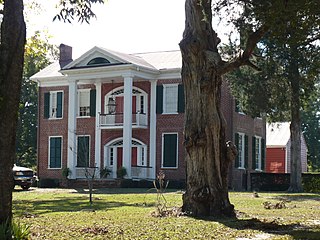
The Tristram Bethea House, also known as Pleasant Ridge, is a historic plantation house in Canton Bend, Alabama. The two-story brick house was built in 1842 in the Federal style. It was added to the National Register of Historic Places on July 11, 1985.

Dry Fork Plantation, also known as James Asbury Tait House, is a historic plantation house in Coy, Alabama. The two-story wood-frame house was built between 1832 and 1834 in a vernacular interpretation of Federal style architecture. It was built for James Asbury Tait by two enslaved African Americans, Hezekiah and Elijah. The floor plan is centered on a hall that separates four rooms, two on each side, on both floors. Tait recorded in his daybook that the house required 25,000 board feet (59 m3) of lumber, the roof was covered with 6,000 wooden shingles, and the chimneys and foundation required 12,000 bricks, made from clay on the plantation. Dry Fork is one of the oldest houses still standing in Wilcox County and remains in the Tait family. It was added to the National Register of Historic Places on February 26, 1999, with the name of Dry Forks Plantation.

The Pine Apple Historic District is a historic district in the community of Pine Apple, Alabama. It was placed on the National Register of Historic Places on February 26, 1999. The boundaries are roughly Wilcox County roads 59, 7 and 61, Broad Street, Banana Street, AL 10, and Adams Drive. It contains 3,350 acres (1,360 ha), 54 buildings, and 1 structures ranging from the Craftsman to Colonial Revival styles.

The Tait–Ervin House, also known as Countryside, is a historic plantation house near Camden, Alabama. The two-story wood-frame house was built in 1855 for Robert Tait by a builder named Henry Cook. Robert was the grandson of Charles Tait, a United States Senator from Georgia. The plantation was acquired after the American Civil War by Robert Tait's sister, Sarah Asbury Tait Ervin, and her husband, Dr. Robert Hugh Ervin. Dr. Ervin served in both houses of the Alabama Legislature and was elected President Pro Tem of the state senate in 1872. The house remained in the Ervin family until 1991, when it was sold to the Phillipi family. The house was added to the National Register of Historic Places on February 24, 1995.

The Wilcox Female Institute is a historic Greek Revival-style school building in Camden, Alabama. The two-story brick structure was built between 1845 and 1850 as a boarding school for girls. The school closed in 1910 and the building was then used by the Wilcox County school system for over 50 years. It was acquired by the Wilcox Historical Society in 1976. The group made it into their official headquarters. It was placed on the National Register of Historic Places on April 3, 1975.

Fairhope Plantation is a historic Carpenter Gothic plantation house and historic district, located one mile east of Uniontown, Alabama, US. The 2+1⁄2-story wood-framed main house was built in the Gothic Revival style in the late 1850s. The plantation historic district includes six other contributing buildings, in addition to the main house. It was added to the Alabama Register of Landmarks and Heritage on December 19, 1991, and subsequently to the National Register of Historic Places on May 29, 1992, due to its architectural and historical significance.

Everhope, known throughout most of its history as the Captain Nathan Carpenter House and more recently as Twin Oaks Plantation, is a historic plantation house near Eutaw, Alabama. Completed in 1853 for Nathan Mullin Carpenter, it is listed on the National Register of Historic Places and Alabama Register of Landmarks and Heritage due to its architectural and historical significance.
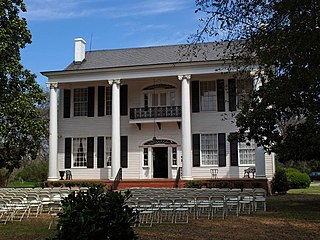
The Montgomery–Janes–Whittaker House, best known today as Buena Vista, is a historic Federal style plantation house in Autauga County, Alabama, south of Prattville. It was listed on the National Register of Historic Places on October 25, 1974. The house is currently owned by the Autauga County Heritage Association and operated as a historic house museum.

The Stone Plantation, also known as the Young Plantation and the Barton Warren Stone House, is a historic Greek Revival-style plantation house and one surviving outbuilding along the Old Selma Road on the outskirts of Montgomery, Alabama. It had been the site of a plantation complex, and prior to the American Civil War it was known for cotton production worked by enslaved people.
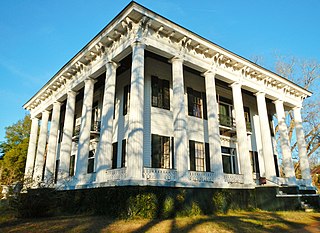
"Meadowlawn", also known as the '"Hagood House", is an antebellum plantation house, built in the Greek revival style, in Lowndsboro, Alabama, United States. It is a contributing property to the Lowndesboro Historic District, which was added to the National Register of Historic Places on December 12, 1973.

The Dr. John R. Drish House, also known simply as the Drish House, is a historic plantation house in Tuscaloosa, Alabama, United States. It is considered by state preservationists to be one of the most distinctive mixes of the Greek Revival and Italianate styles in Alabama. First recorded by the Historic American Buildings Survey in 1934, it was added to the Alabama Register of Landmarks and Heritage on July 31, 1975, and subsequently to the state's "Places in Peril" listing in 2006. It was listed as Jemison School-Drish House on the National Register of Historic Places in 2015.

The 'Wesley Plattenburg House is a historic house in Selma, Alabama. Featuring a unique combination of the Greek Revival and Italianate styles, it was completed in 1842 for Wesley Plattenburg. Plattenburg was born on April 13, 1803, in Anne Arundel County, Maryland. He had relocated to Selma and had assumed the occupation of tailor by 1829. He became a successful merchant and served on the city council of Selma for many years.

Reverie is a historic Greek Revival mansion built circa 1858 in Marion, Perry County, Alabama. It now serves as a residence and also historic house museum. It is listed on the National Register of Historic Places as a contributing property to the West Marion Historic District and was recorded by the Historic American Buildings Survey. It is featured in Ralph Hammond's Antebellum Mansions of Alabama, Gregory Hatcher's Reverie Mansion and Gardens, and Jennifer Hale's Historic Plantations of Alabama's Black Belt.

The Alabama Black Belt National Heritage Area is a National Heritage Area encompassing Bibb, Bullock, Butler, Choctaw, Clarke, Conecuh, Dallas, Greene, Hale, Lowndes, Macon, Marengo, Monroe, Montgomery, Perry, Pickens, Sumter, Washington, and Wilcox counties in the Black Belt region of Alabama. The Center for the Study of the Black Belt at the University of West Alabama serves as the local coordinating authority.

























